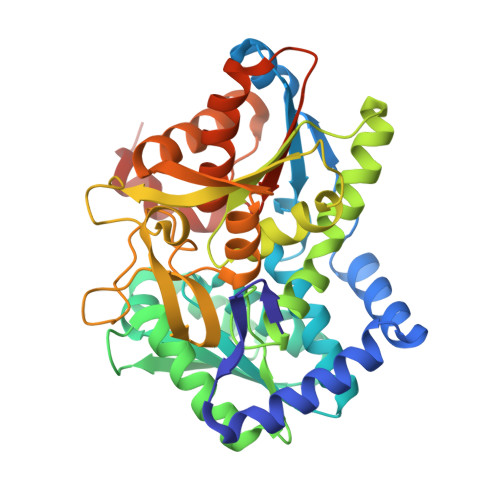Directed Evolution Mimics Allosteric Activation by Stepwise Tuning of the Conformational Ensemble.
Buller, A.R., van Roye, P., Cahn, J.K.B., Scheele, R.A., Herger, M., Arnold, F.H.(2018) J Am Chem Soc 140: 7256-7266
- PubMed: 29712420
- DOI: https://doi.org/10.1021/jacs.8b03490
- Primary Citation of Related Structures:
5VM5, 6AM7, 6AM8, 6AM9, 6AMC, 6AMH, 6AMI - PubMed Abstract:
Allosteric enzymes contain a wealth of catalytic diversity that remains distinctly underutilized for biocatalysis. Tryptophan synthase is a model allosteric system and a valuable enzyme for the synthesis of noncanonical amino acids (ncAA). Previously, we evolved the ¦Â-subunit from Pyrococcus furiosus, PfTrpB, for ncAA synthase activity in the absence of its native partner protein PfTrpA. However, the precise mechanism by which mutation activated TrpB to afford a stand-alone catalyst remained enigmatic. Here, we show that directed evolution caused a gradual change in the rate-limiting step of the catalytic cycle. Concomitantly, the steady-state distribution of the intermediates shifts to favor covalently bound Trp adducts, which have increased thermodynamic stability. The biochemical properties of these evolved, stand-alone TrpBs converge on those induced in the native system by allosteric activation. High-resolution crystal structures of the wild-type enzyme, an intermediate in the lineage, and the final variant, encompassing five distinct chemical states, show that activating mutations have only minor structural effects on their immediate environment. Instead, mutation stabilizes the large-scale motion of a subdomain to favor an otherwise transiently populated closed conformational state. This increase in stability enabled the first structural description of Trp covalently bound in a catalytically active TrpB, confirming key features of catalysis. These data combine to show that sophisticated models of allostery are not a prerequisite to recapitulating its complex effects via directed evolution, opening the way to engineering stand-alone versions of diverse allosteric enzymes.
Organizational Affiliation:
Department of Chemistry , University of Wisconsin-Madison , 1101 University Avenue , Madison , Wisconsin 53706 , United States.


















